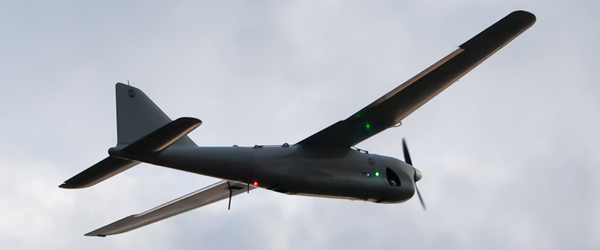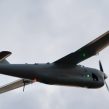
The Rise of Drones in Eurasia (Part Two: Russia)
Publication: Eurasia Daily Monitor Volume: 11 Issue: 117
By:

On May 28, the Ukrainian military reportedly shot down a drone (unmanned aerial vehicle—UAV) that was taking images of a Ukrainian military base engaged in the Anti-Terrorist Operation (ATO) in Donetsk (Dzerkalo Tyzhnia May 28). The Security Service of Ukraine (SBU) identified the drone as a Russian Orlan 10 reconnaissance UAV (ICTV May 30).
This news illustrates several important aspects of Russia’s approach to the military use of drone technology. Unlike Ukraine (see Part One of this article series in EDM, June 23), Russia developed a fairly comprehensive strategy for utilizing unmanned aircraft systems and, more broadly, robotics technology in warfare. The Russian military perceives this strategic approach foremost as “no-contact warfare” (for the origin of this concept see EDM, January 25, 2012). The idea of a no-contact war assumes that the Russian military can defeat a hostile state without the engagement of regular Russian forces, for example through surgical strikes to destroy the adversary’s strategic industrial units or political leadership.
Russian Deputy Prime Minister Dmitry Rogozin outlined the government’s doctrinal views on no-contact warfare in a speech he delivered on June 28, 2013. “No-contact war with an adversary that is technologically superior” would rely on Russia’s strategic nuclear force, he pointed out. And “contact war [would be employed against] an adversary that is approximately at a similar level with us [Russia]. Yet, we should [instead] carry out such a war in a no-contact manner” (Rossiyskaia Gazeta, November 22, 2013). In the Ukrainian conflict, Russia’s use of reconnaissance drones to support the Moscow-backed separatist insurgents is, therefore, consistent with the concept of employing no-contact war tactics against a peer adversary. Though Russia’s actions also raise issues of drone technology proliferation as well as legal issues connected to the cross-border use of such military equipment.
The Orlan 10 UAV is produced by the St. Petersburg company Special Technology Center as a surveillance and reconnaissance system. This drone model has a mission range of 120 kilometers in data transmission mode and up to 1,000 km in autonomous mode. It reportedly has a flight time of 16.5 hours and can fly at an altitude of 5 km. Its surveillance equipment includes both optical photo/video and thermal vision cameras. In 2012, the Orlan 10 was tested for integration with a tactical computer management system (Oruzhiye Otechestva, April 17, 2012). And in August 2013, the Russian state defense company Rosoboronexport mentioned the Orlan 10 together with the Eleron 10 and the Zala 421 as Russian flagship tactical drones (Gudok, August 22, 2013). These three UAV models are used for reconnaissance, surveillance, communications jamming, artillery correction and positional unit support. Indeed, Russian mechanized infantry units exercised using Granat 1, Leyer 3 and Orlan 10 drones specifically for these purposes during a recent Central Military District snap drill (Interfax-AVN via VPK News, June 24). In fact, however, the procurement of drones by the Russian military is still only in its initial stages: just 15 UAV systems were purchased in 2013 (Nezavisimoye Voiennoye Obozreniye, November 15, 2013).
While Russian UAVs are tactically integrated into the military units that use them—for example special companies within the brigades of the 58th Army of the Southern Military District (Zvezda TV, January 13)—the actual procurement of drones is administratively centralized in the “Inter-Force UAV Center” under the General Staff. The complications associated with this misalignment was hinted at by the Russian flagship military newspaper Krasnaya Zvezda, which noted the former problematic attempts to integrate Tipchak drones in artillery units that did not have aviation experience. Largely because of these integration problems, the 2009 review of available Russian drone models led to the decision to procure Israeli UAV systems. Yet, undaunted by this foreign competition, by June 2013, Russian firms presented 35 separate drone models for inspection by Defense Minister Sergei Shoigu. The company Zala Aero even claimed that its drones, which use a proprietary day- and night-time data acquisition system, were technologically superior to similar US and Israeli models (Krasnaya Zvezda, July 1, 2013).
Such claims by Russia’s domestic arms manufacturers fly in the face of a recent report released by the Russian Foundation of Prospective Research (RFPR)—sometimes referred to as the “Russian DARPA”—which asserted that UAVs represent an “area of technology where [the Russian defense industry has] insufficient competencies.” The RFPR further noted that optics and electronics systems for light aircraft were an area of “low competency.” To overcome Russia’s shortcomings, the report prioritized greater domestic R&D and production, while also suggesting foreign technology transfers (RFPR Report, March 31, 2013). For now, drone technology transfer to Russia has not been substantial, as exemplified by the rather protracted attempt to build Israeli United 40 tactical UAVs in Russia (RIA Novosti, February 10, 2014)
Nonetheless, Russian domestic development of drone technology continues, and among the most intriguing projects is the Russian attempt to build a strike drone. On July 6, 2012, it was reported that airplane producer Sukhoi was chosen as the lead designer for this project. Russian UAV expert Denis Fedutinov thinks the UAV might resemble the United States’ X-45 and X-47 or European nEUROn combat drones (Voyenno-Promyshlenniy Kurier September 18, 2013). Other reports indicated that this heavy strike UAV will approximate the technical-operational profile of a sixth-generation fighter (Military Russia, June 25). Another notable project is the development of an advanced reconnaissance drone, the Altius M (Altair), by Gorbunova Aviation Industrial Association in Kazan (Military Russia, March 27).
The development of these advanced UAV systems, in fact, represents a considerable technological challenge for the Russian defense industry, and there are serious questions about whether it can be accomplished without Western cooperation and technological know-how. However, periodic media coverage of some of these domestic developments serves well the government’s propaganda about a resurgent Russia. Interestingly, last year, President Putin called for speeding up the development of Russian UAV systems, but he also criticized the United States for acting unethically in utilizing drone strikes in its foreign campaigns. “Today they [drones] are used more and more widely in the world. We [Russia] will not do it the way other countries do. This is not a game, this is not a computer game,” he declared (Voice of Russia, November 11, 2013). And yet, Moscow’s practice of using drones in covert operations—as illustrated by the deployment of the Orlan 10 to support the insurgents in Donbas—presents its own dubiously legal implications, which are likely to arise ever more frequently the longer the conflict in eastern Ukraine lasts.




